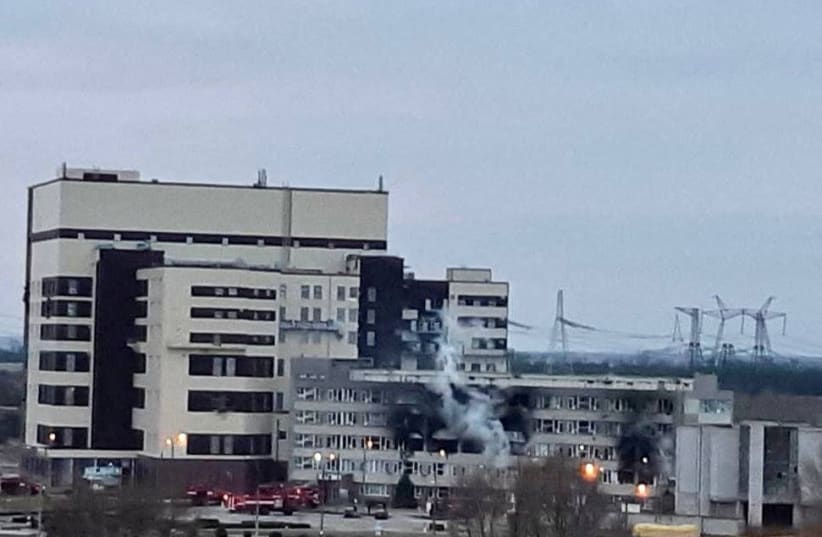Russia's Defense Ministry claims Ukrainian saboteurs were responsible for a "monstrous provocation" that led to the Zaporizhzhia nuclear power plant being fired upon and set aflame on Friday, having provoked Russian forces with small arms fire until they fired at the facility – a narrative that runs stark contrast to Ukrainian reports.
A local authority in Ukraine said Friday that Russian military forces seized the Zaporizhzhia nuclear power plant in Ukraine's southeast after a fire there started by Russian artillery shelling was extinguished.
"Operational personnel are monitoring the condition of power units," it said on social media, adding that the efforts sought to ensure the operations were in line with safety requirements.
A Russian Defense Ministry spokesman said the nuclear plant was operating normally and the area had been under Russian control since Feb. 28.
"However, last night on the territory adjacent to the power plant, an attempt was made by the Kyiv nationalist regime to carry out a monstrous provocation," spokesman Igor Konashenkov said.
"On March 4 at about 2 a.m. during a patrol of guarded territory adjacent to the Zaporozhye nuclear power plant, a mobile patrol of the National Guard came under attack from a Ukrainian sabotage group," he said.
"To provoke return fire on the building, heavy small arms fire was opened on Russian National Guard servicemen from the windows of several floors of a training complex located outside the power plant."
He said the Russian patrol returned fire to suppress the attack, and the "sabotage group" abandoned the training complex, setting fire to it as they left.
The account was diametrically opposed to Ukraine's version of events.
Though worrying, the fact that the fire was put out extinguishes fears that the damage to the power plant could have resulted in a major nuclear disaster.
In a statement early Friday morning, Ukrainian President Volodymyr Zelensky said the targeting of the nuclear power plant was no accident.
"Russian tanks are equipped with thermal imagers, they know where to shoot," Zelensky said in a video address.
He compared the possible disaster to what occurred in 1986 at the Chernobyl nuclear power plant.
The Chernobyl disaster occurred after a safety test went wrong, making it unstable and leading to a chain reaction, exploding the reactor core. The nuclear cloud spread for around nine days throughout the region.
The exact death toll of the disaster is unknown, as while two people were killed in the original explosion itself, many more died throughout the following months from radiation poisoning and many more throughout the following years of cancer. According to a 2006 article published in the academic journal Nature, the death toll in the USSR alone was estimated to reach around 4,000, while extending into Western Europe, that number could be even higher, with some studies ranging from 16,000 to even 60,000.
But while the disaster itself is long gone, the damage continues to this day. As noted by Nature, many areas around the reactor and beyond are still affected by the radiation. The most prevalent type of radioactive isotope in the disaster, caesium-137, has a half-life of around 30 years, so much of the areas left abandoned by the blast could get better in the coming years, but many areas could be radioactive for centuries to come, like the 30 kilometer exclusion zone around the reactor itself.
And Russia, Zelensky argued, wants to repeat this.
"This is the first time in the history of mankind that a state has resorted to nuclear terror," the president said, noting that no one has ever fired on nuclear power stations before.
In fact, according to Foreign Minister Dmytro Kuleba, a nuclear disaster at Zaporizhzhia would be 10 times worse than what happened in Chernobyl.
A nuclear disaster at the Zaporizhzhia plant would spell catastrophe for all of Europe, he continued.
"If there is an explosion, it's the end of everything," Zelensky said. "Do not allow Europe to die from this catastrophe."
Despite the shelling-induced fire, Ukraine's regulatory body said "essential" equipment was not damaged and radiation levels at the plant had not been changed.
The International Atomic Energy Agency (IAEA) called for a halt in hostilities due to the dangers of a nuclear disaster if the reactors were hit. IAEA Director-General Rafael Grossi said the plant is only operating at 60% at this time.
This is a developing story.
